
|
Sale 35
Manuscript and Collectibles Auction
| Lot |
Photo |
Description |
Realized |
Lot 789 |
 |
10½ Pound Dinosaur Coprolite. Dinosaur excrement is highly sought after both as a conversation and for study by a group of scientists called scatologists. This hugh 6 1/2" long x 4 1/4" wide x 5 1/2" high, 10 1/2 lb. specimen could only be from a dinosaur, since dinosaurs were the only really large animals populating the Morrison Formation near Garfield, Utah 150 million years ago. The specimen was originally larger, but it lost moisture and shrank during the fossilization process and about one fourth of it is missing on one end. The outer surface is a rust-orange color while the interior is a mixture of browns and grays with flecks of orange. Also included is a polished 4 ½" x 2 ½" section to show the colors and patterns of the interior of the coprolite. The various colors are due to bacteria breaking down the organic compounds of the coprolite and mineralization of the fossilization process. Add $25 for domestic shipping.
Estimated Value $275 - 425.
View details and enlarged photo
| Unsold |
Lot 790 |
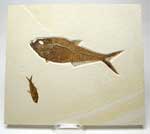 |
10 Inch Long Diplomystus From Green River. Diplomystus was an extinct genus of herring-like fish that lived in the shallow fresh water lakes of Green River, Wyoming 50-55 million years ago. This 14 1/2" x 12 1/2" cream-colored sandstone slab contains a museum-quality 10" long Diplomystus with fins, small bones, head, and even dark brown skin impressions clearly visible. Only some of the tinest bones of the delicate fins have been enhanced. Also on the same slab is a perfectly preserved 3" long Knightia, which was a favorite prey fish of Diplomystus. The ¾" thin slab has been cleanly cut and can be easily framed if desired. Add $35 for domestic shipping.
Estimated Value $600 - 900.
View details and enlarged photo
| Realized
$776 |
Lot 791 |
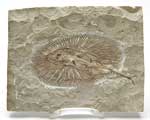 |
100 Million Year Old Short Tailed Skate From Hakel, Lebanon. Cyclobatis was a small bottom-dwelling skate found in the warm seas of 100 million years ago near Hakel, Lebanon. This outstanding, full-size skate is 7" x 3 1/2" and is complete with its tiny cartilaginous spines, three small stingers on its tail and even two black spots where its eyes were located. The medium brown adult skate is nicely centered on an 8 1/2" x 7" gray-brown matrix. The cretaceous seas of Lebanon were known for their fish, but the skates and rays are much rarer and highly sought after by collectors. Add $25 for domestic shipping.
Estimated Value $600 - 850.
View details and enlarged photo
| Realized
$805 |
Lot 792 |
 |
12" Jaw Section From A Mosasaur. Mosasaurs were the top predator of the Cretaceous seas 65-85 million years ago. Like the T-Rex on land, Mosasaurs ate whatever they wanted in the sea. This large 12" jaw section with up to 2" long pointed teeth belonged to a large 20-30 foot long Mosasaur that swam in the warm seas that covered Morocco 70-80 million years ago. Today, these ancient seas are part of the Sahara Desert. This large jaw section is nicely centered on a 17"x9" limestone matrix. This large, showy fossil would be a nice addition to any fossil collection. Add $25 for domestic shipping.
Estimated Value $400 - 800.
View details and enlarged photo
| Realized
$489 |
Lot 793 |
 |
140 Million Year Old Aquatic Reptile From China. This excellent fossil of a 12" long marine reptile is both visually impressive and important as a fossil as this small aquatic reptile was the very first known reptile to return to the sea 260 million years ago, shortly after evolving from amphibians. They also prove the theory of continental drift as they are found on the western part of South America and the eastern coast of Africa, proving that the two continents were connected 260 million years ago. This dark brown fossil has excellent bone definition with well defined ribs, two back feet with most of the tiny foot bones, complete tail, and a skull which has a number of sharp little teeth visible somewhat similar to those of a crocodile. Only the two front legs are missing. This impressive pre-dinosaur reptile is well centered on its natjural 14"x6" light gray stone matrix. Add $20 for domestic shipping.
Estimated Value $350 - 500.
View details and enlarged photo
| Realized
$518 |
Lot 794 |
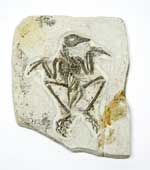 |
140 Million Year Old Bird Fossil From China. Some of the oldest bird fossils ever found come from Liaoing Province of Northeastern China. This small 4" primitive bird, Liaoxiornis delicatus, was alive in the late Jurassic 140-135 million years ago. Only Archaeopteryx from Germany is older at 150 million years old. This virtually complete bird is remarkable in the details of its preservation. Birds have light delicate bones that are rarely preserved. Due to an enormous volcanic eruption 140 million yeatrs ago, this bird was killed by the poisonous gases and quickly buried in the volcanic ash that slowly hardened over millions of years to form the very soft stone matrix that still surrounds the delicate bones.
The fossil is a dark brown color against a creme tuffaceous stone matrix. This remarkable specimen is complete except for two fingers in the hands and a couple of claws on the foot bones. The skull is one of the best known with a clear eye and even several small sharp teeth near the tip of the beak. Each hand has two sharp claws on them which defines their primitive status as compared to modern birds. Even the delicate wish bone is clear surrounding the tail vertebrae. This museum quality has been placed in a 5"x6" Ryker mount for protection. Add $20 for domestic shipping.
Estimated Value $3,000 - 4,000.
View details and enlarged photo
| Realized
$3,220 |
Lot 795 |
 |
150 Million Year Old Crustacean From Solnhofen, Germany Fossil Bed. This bizarre 6 ½" lobster-like crustecean known as Mecochirus longimanatus is unusual in having an unbelievably long front pair of walking legs with pincers. The front legs are 4" long (two thirds the length of the crustecean). Mecochirus used such long legs to raise itself out of the sand and swing its body backwards.
Encased in a 16x12" Ryker Mount. Solnhufen is famous for the site of the first bird Archaeopteryx (Jurassic). Mecochirus is rarely found as well preserved as this specimen because it had a very thin shell. Add $30 for domestic shipping.
Estimated Value $500 - 750.
View details and enlarged photo
| Unsold |
Lot 796 |
 |
150 Million Year Old Horseshoe Crab. Horseshoe crabs are living fossils that can trace their origin back over 500 million years. They have always been rather rare animals that started out being very small and have grown larger over the past 500 million years. They are extremely as fossils with the 150 million year old specimens from Solnhofen, Germany being the most famous. Mesolimulus was a small horseshoe crab that rarely grew over 8" long. This museum quality specimen is 6 1/4" x 3" wide, nicely centered in an 8" x 8" matrix. The fossil is 3-D with excellent shield detail, as well as spines and a complete tail. Just to the left of the fossil horseshoe crab, there are two small raised lines where the animal dragged its tail before expiring from lack of oxygen. There is excellent contrast with the specimen being dark beige on a light beige matrix. Top quality specimens such as this one are rare. Add $30 for domestic shipping.
Estimated Value $1,000 - 1,400.
View details and enlarged photo
| Realized
$891 |
Lot 797 |
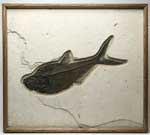 |
18½" Long Diplomystus--52 Million Year Old Fish. This enormous 18 1/2"x5" museum quality fish is from the Green River area of Wyoming and was a very large relative of a herring-like fish that lived in the 50-55 million year old shallow lakes that dried up at that time in Wyoming. At over 18" long, this Diplomystus is just about as big as they are ever found and is a magnificent specimen as well. The incredible fish is virtually complete with an outstanding head with a few teeth visible, complete vertebrae, dark brown skin impressions and most of the delicate fine fins with only minor enhancement of some of the tiniest fins. There are even some small fish coprolites present on the large 26"x23" cream-colored limestone matrix. This very special fish has been professionally mounted and framed for hanging. This is the perfect specimen for any fisherman or fossil collector. Add $100 for domestic shipping.
Estimated Value $1,000 - 1,500.
View details and enlarged photo
| Realized
$1,323 |
Lot 798 |
 |
20 Million Year Old Fossilized Plants and Flower. Complete, finely-detailed plant fossils are rare, and flowers are much rarer still. These beautiful brown and gray fossils from Shanddong Province, China are preserved as thin carbon layers in thin pieces of diatomaceous shale. This impressive display consists of a large 1 ¼" flower with five fine petals, a 4" long complete brown leaf with excellent vein detail, and a pair of leaves 4 ½" and 4" long sharing a 1 ½" stem. This diverse and high quality grouping is attractively displayed and protected in a 12x8" Ryker mount. Add $15 for domestic shipping.
Estimated Value $200 - 400.
View details and enlarged photo
| Realized
$173 |
Lot 799 |
 |
200 Million Year Old Dinosaur Footprint. Over 200 million years ago, near Lincoln Park, New Jersey, a medium size predatory dinosaur walked in the mud near the ocean, leaving its footprints preserved for all time. This excellent, well-defined theropod footprint measures 7x3" centered on a 7 ½x3¾" matrix. The detail is excellent with even the claws imprinted at the ends of the toes. The center toe is longer than it should be, perhaps because the dinosaur slipped slightly in the mud. This type of footprint has the name Grallator cunceatus, although the actual dinosaur that made the footprint is unknown. Add $15 for domestic shipping.
Estimated Value $300 - 450.
View details and enlarged photo
| Realized
$230 |
Lot 800 |
 |
225 Million Year Old Gymnosperm Plant From Australia. Glossopteris browniana was a strange type of tree known as Pteridospermale, and only grew in the Southern Hemisphere. This very colorful 14"x8" slab contains at least nine leaves, plus several partials, the largest being 4" long and ranging in color from yellow to brown to reddish brown. The quality of the leaves is extraordinary with tiny vein details visible. A most attractive and large specimen of one of the strange early trees of the late Permian Period. Found in the Illawarra Coal, Dunedoo, North S.W. Australis. Several more leaves and parts are visible on the bottom side of the slab. Add $20 for domestic shipping.
Estimated Value $300 - 450.
View details and enlarged photo
| Unsold |
Lot 801 |
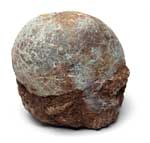 |
30 Million Year Old Duckbill Dinosaur Egg. This complete unhatched Hadrosaur (duckbilled) dinosaur egg is 70-80 million years old and measures 6 ½" long and 5 ½" wide. It was found by farmers from the Xixia, Henan Province of China. The exact species of dinosaur cannot be determined from just an egg, but this shape of egg has been determined to be from a duckbilled dinosaur from duckbilled dino bones found in the area of the nests of eggs. Such a Hadrosaur duckbilled dinosaur is Shantungosaurus, which has been found in the same area as the eggs and was one of the largest Hadrosaurs at more than 50 feet long. Duckbills herded together and nested in great numbers (100-200 large animals). Add $25 for domestic shipping.
Estimated Value $350 - 500.
View details and enlarged photo
| Realized
$719 |
Lot 802 |
 |
450 Million Year Old Spiny Trilobite From Morocco. Selenopeltis bucchi was an unusually large spiny trilobite that crawled on the seafloor of the warm seas of Western Morocco 450 million years ago. Trilobites developed spines as a form of protection to keep from being swallowed by giant worms and other predators. it was the first arms race as predators eventually developed teeth and trilobites developed ever larger and sharper spines. Most spiny trilobites were only one to three inches long, but this Selenopeltis is much larger at 6" x 4". It is complete with all its long spines facing backward and is a dark brown color on a light gray matrix. This rare trilobite, missing from most collections, is nicely centered on a 9" x 7" stone matrix. Add $25 for domestic shipping.
Estimated Value $450 - 700.
View details and enlarged photo
| Realized
$540 |
Lot 803 |
 |
A 50 Million Year Old Fish Swallowing Another Fish. One of the rarest and most sought after Green River Wyoming fossil fish plates is one having a fish aspiration: a fish that choked to death while swallowing whole another fish. The larger predatory fish is a 7" long Mioplosus that was attempting to swallow a 2" long Knightia. This fossil captures the exact moment in time 50 million years ago that both fish expired and settled on the bottom of the shallow lake and became covered with silt and nearly perfectly preserved. Both fish are excellently preserved with their bones, scales and fins preserved being dark brown in color, nicely contrasting the creamy tan 10" x 5 1/2" matrix. A few of the delicate thin fin rays have been enhanced, but overall this is one of the clearest and most dramatic of fish aspirations and is preserved in a 12" x 8" Ryker mount. Add $30 for domestic shipping.
Estimated Value $1,500 - 2,500.
View details and enlarged photo
| Realized
$3,565 |
Lot 804 |
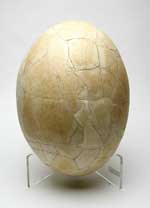 |
An Elephant Bird Egg--The Largest Bird Egg Known. Aepyornis maximus, the elephant bird, laid the largest egg of any bird known. These eggs would hold over eight quarts of yolk, the equivalent of 170 chicken eggs. These giant birds, over ten feet tall, lived on the remote island of Madagascar until they became extinct 400 to 500 years ago. These giant flightless birds may have been the birds responsible for the legend of the "Roc" birds told by Arab sailors who sailed these waters. Occasionally, these eggs are found in eroding sand dunes on the coast of Madagascar, broken by their burial in the sand for hundreds of years. The rare eggs are then carefully reassembled. This excellently-shaped egg is 12" tall and approximately 9" in diameter, and comes with its own base for display. Add $40 for domestic shipping.
Estimated Value $1,400 - 2,200.
View details and enlarged photo
| Realized
$2,530 |
Lot 805 |
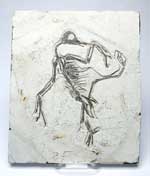 |
Complete 140 Million Year Old Bird From China. Because birds have such delicate bones, they rarely fossilize, which is why the early history of bird evolution was poorly understood. The spectacular Jurassic-early Cretaceous fossils of Liaoning Province, China have changed all of this. We now know that birds are a type of dinosaur, with the most primitive birds such as Eoenantiornis still possessing teeth and claws on their wings. Eoenantiornis buhleri was a medium size primitive flying bird that lived 135-140 million years ago near Shanguan, Beipiao City, Liaoning Province of China.
This complete, magnificent speciment is 9" long on a 12" x 10" Tuffaceous stone matrix, which resulted from the volcanic ash of a gigantic eruption 135 million years ago compressing into a soft thin layer of rock over many millions of years. The inevitable cracks in this soft matrix have been smoothed and covered with gypsum and then backed for stability. The museum-quality specimen is perfectly centered and virtually complete with every delicate rib bone, head, claws, and even the V-shaped Furcula (wishbone) visible. The wings were 5" long with huge fingers and claws on its end. As a matter of fact, the claws on the wings were much larger than the claws on its feet, left over from their theropod dinosaur originas. This is a rare opportunity to acquire a very rare, important, and impressive fossil. Add $35 for domestic shipping.
Estimated Value $4,000 - 6,000.
View details and enlarged photo
| Realized
$5,175 |
Lot 806 |
 |
Complete Curved Mammoth Tusk. Complete tusks from a wooly mammoth, Mammuthis primigenius, are rare. This complete 50" long tusk is a beautiful dark brown color with several different shades of brown blending to give it a very striking appearance. The fossil ivory has been polished to preserve it plus add to its beauty. These colors resulted from the original white ivory being mineralized over thousands of years with minerals such as vivianite and iron phosphate. This museum-quality tusk was found in the Taymyr Peninsula of Siberia and is between 30,000 and 100,000 years old. Most Mammoth tusks recovered are broken and only partials, obtaining a complete tusk without paying many thousands of dollars is a real buying opportunity. Add $85 for domestic shipping.
Estimated Value $3,500 - 4,750.
View details and enlarged photo
| Realized
$3,680 |
Lot 807 |
 |
Complete Skull From A Giant Cave Bear. This beautiful complete 18" x 9" skull is fro Ursus spelaeus, the largest bear that ever lived. These giant cave bears roamed Rurope from 300,000 to as recently as 10,000 years ago. From cave paintings made by ice-age humans, we know that cave bears somewhat resembled a grizzly bear, but were larger, standing over 10 feet tall. This superb complete skull is a light brown color with excellent bone quality and all teeth still in their sockets. The fearsome incisor teeth are just over 2" long. These cave bears are between 25,000-35,000 years old and were found in caves in the Bihor Mountains of Romania. Cave bears certainly have one of the largest and most impressive of the early mammal skulls and few skulls are as complete and superb as this one. Add $50 for domestic shipping.
Estimated Value $2,500 - 3,500.
View details and enlarged photo
| Unsold |
Lot 808 |
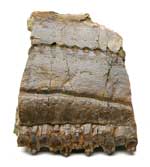 |
Duckbilled Dinosaur Lower Jaw Section With 11 Large Teeth. Individual dinosaur teeth are rare, but jaw sections with original teeth still in place are usually only found in museums. This 3 ½x4½" lower jaw section is from a famous duckbilled dinosaur, Edmontosaurus. It was extracted from the 70 million year old Oldman formation in the Red Deer Valley of Alberta. The jaw is a rich chocolate brown color with eleven 1" dark brown teeth. Unlike mammals, dinosaurs continually replaced their teeth throughout their lives. This unusual fossil shows how tooth replacement occurred. From its side the outline of replacement teeth are clearly visible. As the teeth on top of the jaw were worn and lost, the teeth beneath them would rise to the surface of the jaw to take their place. Much information can be gained by studying this impressive and striking fossil jaw section. Add $15 for domestic shipping.
Estimated Value $400 - 650.
View details and enlarged photo
| Unsold |
Lot 809 |
 |
Grouping of Seven Keichosaurs On One Plate. Keichosaurus was a 240 million year old marine reptile found in the Guizou Province of China and the ancestor of the huge Plesiosaurs of the Cretaceous. The Loch Ness monster was thought to be a long-necked Plesiosaur. Like Plesiosaurs, Keichosaurus had a long flexible nick, tiny sharp teeth, webbed feet and a tail as long as its neck. This museum-quality grouping consists of seven nearly-complete Keichosaurs on one large 26 1/2" x 20" matrix. The Keichosaurs vary in length from 5" to over 10" long with all but one being adult animals between 8-10" long. The small juvenile specimen has an adult specimen interestingly placed on top of it. The detail on the specimens is extraordinary with delicate heads, limbs and small delicate claws well defined. There is about 20% restoration on some of the specimens to complete the limbs, ribs or strengthen the delicate head bones which are often missing or incomplete. However, this work has been professionally done and blends in superbly, making this specimen dramatic and life-like; the Keichosaurs seem to be swimming in a circular pattern around the hard dark gray slate matrix. The bones are black in color, contrasting nicely with the gray slate. Four of the specimens are dorsal positions and three are ventral positions. This is determined by the skulls, the dorsal position skulls are full with eyes and the ventral position skulls show just an outline of the lower jaw. This museum-quality fossil plate will be the highlight of any collection. Add $100 for domestic shipping.
Estimated Value $3,750 - 5,000.
View details and enlarged photo
| Realized
$4,025 |
Lot 810 |
 |
Important New Dinosaur--Jeholosaurus From China's Early Cretaceous Period. This is the first auction of a new rare ornithopod dinosaur from Liaoning, China, Jeholosaurus shangyuanensis. This exquisite specimen is more complete than the discovery holotype specimen with a better skull and more than 85% of the total skeleton present in the original matrix.
The exact relationship of Jeholosaurus to known groups of dinosaurs has not been determined fully at the present time. It is an Ornithipod and seemingly closely related to taxa referred to as hypsilophodontids. Hypsilophondontosaurus itself is not well understood, with only a single, near-complete specimen known. The name hypsilophdontid refers to the different shape teeth present in the jaw with the back teeth being somewhat flat like a plant eater and the front premaxillary teeth being sharp and pointed like a meat-eating dinosaur. This probably means that gypsilophondontids like Jeholosaurus were omnivores eating both plants and insects and possibly small lizards. Being an insectivore is consistent with the body of Jeholosaurus which had fragile light bones and long legs capable of great speed in running.
Jeholosaurus was found in the 130 million year old tuffaceous sandstone fo the lower Yixian formation near Shan gyuan, Liaoning Provinince, China. 130 million years ago an enormous volcanic eruption occurred burying everything within a 50-60 mile radius. This dinosaur Pompey resulted in the preservation of small delicate dinosaurs. Some even with feathers.
This spectacular dinosaur, Jeholosaurus, is 28 inches long with a superb skull 2½x2½", containing at least 10 teeth in the upper jaw and 6 teeth in the lower jaw. Most known skulls of Jeholosaurus have been crushed and distorted. This skull is the exception with only the backside crushed or still buried in the matrix. The front legs are 10 inches long, the backlegs 13 inches long, and the long tail 14 inches long, which is half the length of the complete dinosaur. One front leg and both back legs are exposed. Part of the missing front leg does show and the rest of it could still be buried in the matrix. The body and tail are quite complete, just missing some of the delicate neural spines.
This is a rare opportunity to purchase a rare dinosaur missing from most museums outside of China. Add $200 for domestic shipping.
Estimated Value $17,000 - 25,000.
View details and enlarged photo
| Realized
$12,650 |
Lot 811 |
 |
Large 7" x 8" Mammoth Tooth Embedded In A Partial Mandible. This complete dark brown Mammoth tooth is still set in a portion of the lower jaw that has been cut away to reveal a very interesting, honey-combed shaped bone structure. The hollows and cavities in the bone helped reduce the weight of the jaw, as well as allowed blood flow. This exquisite fossit is 30,000-50,000 years old from Siberia, where the best preserved Mammoths have been found. The flat surface of teeth was used to grind coarse vegetation. The alternatingrows of dark brown enamel and lighter brown dentine is clearly visible in this museum-quality fossil. A single, intact Mammoth tooth is a highly-desired fossil, but one with part of a cut-away jaw adds much to its desirability and collector value. Add $25 for domestic shipping.
Estimated Value $500 - 800.
View details and enlarged photo
| Unsold |
Lot 812 |
 |
Large Four Inch T-Rex Tooth. All T-Rex teeth are rare and highly coveted by both museums and collectors alike. Most individual, shed, large teeth are put into partial skulls that are missing some teeth. This large 4" shed tooth was recovered from the famous Hell Creek Formation in Harding County, South Dakota. Almost all recovered T-Rex teeth are shed teeth, meaning that they broke off a living T-Rex while it fed on another dinosaur. Teeth with roots are only obtained from the jaw of a T-Rex that died. Most shed teeth are only 1-2" long, thus finding one as big as this one is very rare. Before being shed, this tooth would have had a root more than twice as long as the shed enamel, making this enormous tooth over one foot long. l This highly-desirable tooth has the wide diameter spike-like shape that defines a T-Rex tooth from alal other theropods. All recovered teeth have some cracks and breaks from being buried for more than 65 million years. The cracks and breaks on this tooth have been professionally restored, giving the tooth a nice, even brown color and attractive appearance. The all-important tip of the tooth is intact, with just some natural wear that occurred when the T-Rex was alive. T-Rex teeth would continue to grow longer until they broke off and thusly would have some wear on the sharp tip from biting into solic bone. This spectacular tooth has been placed on its own 3" x 3" wooden stand for display and would be the centerpiece of any dinosaur collection. Add $20 for domestic shipping.
Estimated Value $2,500 - 4,000.
View details and enlarged photo
| Realized
$2,185 |
Lot 813 |
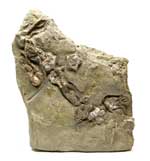 |
Large Group of Armored Crinoids. Crinoids can resemble a plant but are actually an echinoderm related to star fish and sea urchins. These highly unusual animals filtered various small marine animals as they were attached to the sea bottom. Jimbacrinus bostocki was an extremely unusual crinoid that somewhat resembles an armored octopus with five arms instead of eight. Jimbacrinus would anchor itself to some object on the sea bottom and use its five arms like tentacles to catch small food items swimming by. This 12" x 10" stone matrix contains 16 nearly complet calyxes (heads) and several of the five arms that each one possessed. The tiniest detail is amazing with some of the arms having very small extensions analogous to the hooks attached to the tentacles of squid. The crinoids are 3-D and are visible on both sides of the matrix with 10 Calyxes on one side and 6 Calyzes on the back side. The entire specimen can stand upright on its own to display both sides. Jimbacrinus were 260 million years old and were found in the Northwest Territories of Australia. With even one single specimen bringing hundreds of dollars, such a large mass mortality group represents an excellent buying opportunity. Add $50 for domestic shipping.
Estimated Value $1,800 - 2,750.
View details and enlarged photo
| Unsold |
Lot 814 |
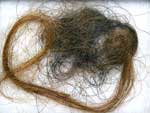 |
Large Patch of Wooly Mammoth Hair. This exceedingly rare specimen of wooly mammoth hair consists of a very long strand of reddish-brown hair that has a small patch of soft tan inner hair as well. Also, there is a patch of black hair that is much rarer than the reddish-brown hair. There is over ten times as much hair in this lot as normally offered. More than 30,000 years old, this remarkable hair comes from the frozen carcass of one of only 12 Wooly Mammoths found frozen in the permafrost of the Indi-girka Basin of Siberia. This specimen of Mammuthis primigenius hair was part of the collection owned by Dr. Gennady Baryshnikov, head of the History Faunas Department Zoological Institute, USSR Academy of Sciences in Leningrad. Housed in a 9" x 6 1/2" Ryker mount. Add $15 for domestic shipping.
Estimated Value $600 - 900.
View details and enlarged photo
| Unsold |
Lot 815 |
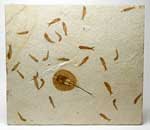 |
Mass Mortality Plate of 26 Fish and A Stingray. Stingrays are one of the most highly-valued fish fossils from the 52 million year old Green River formation of Wyoming. Not only does this large 20" x 17½" limestone plate contain an excellent juvenile 7"x3" long stingray, but it also has a school of 26 small Gosiutichthys which was a relative of the modern day herring. Single fish fossils are highly desired but mass mortality fossils such as this assemblage are rarely encountered and in great demand. The position of the fish could not be better as the 26 small fish appear to be swimming aroung the small sting ray. The detail on the stingray is excellent with the all-important tiny rays well defined in the central disk, as well as the delicate bones in the bones. Only the end of the tail and two stingers have been restored. The fragile limestone has been backed with wood for stability and the slab has been nicely squared off. Can be framed for hanging. Add $50 for domestic shippiing.
Estimated Value $1,750 - 2,750.
View details and enlarged photo
| Realized
$2,185 |
Lot 816 |
 |
Massive Two Feet Long Triceratops Brow Horn. Triceratops is one of the most famous and recognizable dinosaurs with its two long sharp brow horns that it used for defense against the T-Rex as well as fighting for mates. No complete skeleton has ever been found, but occasional skulls and horns are found in Montana. Such is the case here with a virtually complete supraorbital horn (brow horn) in excellent condition. This enormous horn is two feet long with an 11 inch diameter base. As always, there are some cracks that have been professionally filled and perfectly blended in color and texture to the dark brown bone. The horn is straight and distorted like most offered and has an excellent tip which is missing in most specimens. When alive the horn bone was covered in keratin, the same substance that makes up our finger nails, and would have been about 30% larger. This is one of the largest and best quality Triceratops horns to be offered at auction in several years. Add $65 for domestic shipping.
Estimated Value $3,000 - 4,000.
View details and enlarged photo
| Realized
$2,300 |
Lot 817 |
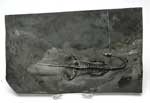 |
Mini Guizhou Dragon--A 240 Million Year Old Marine Reptile. This excellent fossil of a 12" long marine reptile is both visually impressive and important as a fossil as this small aquatic reptile was the very first known reptile to return to the sea 260 million years ago, shortly after evolving from amphibians. They also prove the theory of continental drift as they are found on the western part of South America and the eastern coast of Africa, proving that the two continents were connected 260 million years ago. This dark brown fossil has excellent bone definition with well defined ribs, two back feet with most of the tiny foot bones, complete tail, and a skull which has a number of sharp little teeth visible somewhat similar to those of a crocodile. Only the two front legs are missing. This impressive pre-dinosaur reptile is well centered on its natural 14"x6" light gray stone matrix. Add $25 for domestic shipping.
Estimated Value $500 - 750.
View details and enlarged photo
| Realized
$460 |
Lot 818 |
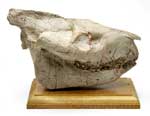 |
Museum-Quality Merycoidodon Mammal Skull. Merycoidon was a strange 30 million year old mammal that had some features like a pig and some features like a camel or deer. The skull was somewhat pig-like but had pits in front of its eyes, very similar to a modern deer. This large 8x4" skull is complete and is nearly perfect with no restoration and a complete set of teeth, including the large sharp canines. The teeth are a lovely dark brown color which contrasts with the tan-colored bone of the skull and the very hard light tan matrix which still fills the inner part of the skull. Found in the badlands of South Dakota, museum quality skulls such as this one are rarely found and are in great demand. Comes expertly mounted on its own wooden base but is removable for study. Add $30 for domestic shipping.
Estimated Value $850 - 1,250.
View details and enlarged photo
| Unsold |
Lot 819 |
 |
Near Complete Mesosaurus Sleleton. This excellent fossil of a 12" long marine reptile is both visually impressive and important as a fossil as this small aquatic reptile was the very first known reptile to return to the sea 260 million years ago, shortly after evolving from amphibians. They also prove the theory of continental drift as they are found on the western part of South America and the eastern coast of Africa, proving that the two continents were connected 260 million years ago. This dark brown fossil has excellent bone definition with well defined ribs, two back feet with most of the tiny foot bones, complete tail, and a skull which has a number of sharp little teeth visible somewhat similar to those of a crocodile. Only the two front legs are missing. This impressive pre-dinosaur reptile is well centered on its natjural 14"x6" light gray stone matrix. Add $20 for domestic shipping.
Estimated Value $1,000 - 1,500.
View details and enlarged photo
| Unsold |
Lot 820 |
 |
Nest of Seven Oviraptor Dinosaur Eggs. Nest of seven dinosaur eggs from oviraptor, one of the most famous and important dinosaurs. One of the most desirable of dinosaur eggs belongs to the strange theropod, Oviraptor. The name Oviraptor means egg stealer and when first found near the nest, they were thought to have died trying to eat the eggs. An amazing discovery in 1995 of a near complete Oviraptor actually sitting on a nest made it apparent that the Oviraptor was actually brooding the eggs (picture included with lot). Embryonic bones found in some of these black eggs confirmed that they were Oviraptor young. Oviraptors were about 8 feet long, had a toothless beak and wre on of the most bird-like of non-avion theropods.
The museum-quality, 7-egg nest comes from the Nanxiang Basin, Guandong Province of China and is about 70 million years old. All of the eggs display their original unhatched shape, as well as 80% of their original black shell with the detail typical of raptor eggs. Oviraptors laid their eggs two at a time; as this partial nest displays, the eggs were laid two by two in two layers. The 7" long eggs reside in their original 15"x11" red sandstone matrix that has been flattened on the bottom for easy display, or they can be displayed standing upright. As no more dinosaur eggs are currently coming out of China, this is an important opportunity to acquire a museum-quality clutch of eggs. Individual eggs sell for $1,999 or more and nests are much rarer. Add $100 for domestic shipping.
Estimated Value $4,000 - 6,000.
View details and enlarged photo
| Realized
$3,335 |
Lot 821 |
 |
One Of The Best Ever Mounted Psittacosaurus Dinosaurs. This 38" long male Psittacosaurus dinosaur is one of the very best ever offered for sale, being more than 90% real bone, as well as having the skull completely opened up with all of the stone matrix removed. The opened-up skull reveals the very delicate inner skull bones that are usually crushed or missing on most specimens. The very time-consuming and detailed skull work also resulted in the teeth being carefully prepared in place. The bone quality is also exceptional being a solid light tan color, not porous and brittle. What also adds to the esthetics and value of this fossil is the extraordinary mounting. This dinosaur has been mounted in a position based on the very latest information on what it may have looked like in life. It has three feet on the ground and is turning its head and lifting one leg as if it were startled. This was modeled on the latest full-body cast made by the Museum of Natural History in New York (a photocopy enclosed). Amazingly, the dinosaur has been mounted with no supporting rods visible, which has never been done before. A steel rod has been placed under the vertebrae from the head to the tail, as well as small wires meticulously inserted in the center of all the arms and leg bones. All of this detailed work has resulted in the most stunning and real-looking dinosaur specimen.
This important specimen of dinosaur is between 125-130 million years old and is so well preserved because it was buried in a massive volcanic eruption in Liaoning Province, China at that time. Psittacosaurus (parrot-beaked dinosaur) was the oldest of the Ceratopsians--horned dinosaurs. Psittacosaurus did not have large horns like its more famous relative Triceratops, but did possess a horned beak, horned Jugals (back of the upper skull) and in males such as this specimen, small horns on the top of their nose, just in front of their eyes. Only the males had these small horns which would have had limited defensive value and were probably just used ornamentally to attract a mate. Male specimens with horns are much rarer than female specimens. All of these horns would have been covered in keratin when the animals were alive, which would have made them bigger, ending in sharp points. The skull, tail, and all four limbs can easily be removed for study. This extraordinary dinosaur has complete real bone except for most of the ribs, a few teeth, and a small number of the small delicate neural spines. Add $500 for domesic shipping.
Estimated Value $13,500 - 20,000.
View details and enlarged photo
| Realized
$10,350 |
Lot 822 |
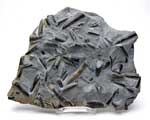 |
Over 50 Belemnites On A 180 Million Year Old Slab. 180 million years ago, Belemnites, extinct relatives of squid were very numerous in the seas of southern Germany near Holzmaden. The main difference between Belemnites and modern squid was that Belemnites had a shell guard inside their bodies in their tail area. These bullet-shaped shells strengthened their tail sections and are the only part of these soft-bodied animals that fossilized. Finding one or two in a slab would be what would normally be expected. Such a large accumulation (more than 50 Belemnites) in such a small area 10x9" slab most likely was the stomach content of a large predator (fish armosascum) that ate all of these extinct squids. The size of these Belemnites varies from ½" to over 2" in length and comes from several different species of Belemnites. This is a spectacular fossil with a story to tell. Add $15 for domestic shipping.
Estimated Value $250 - 375.
View details and enlarged photo
| Unsold |
Lot 823 |
 |
Pair of Cave Bear hands Complete With Sharp Claws. Ursus spelaeus, the Cave Bear, was the largest bear that ever lived and has only been extinct for 10,000 years. These 11" long and 5" wide left and right hands are complete down to the claws, which are over 1" long and mounted with wires so that they can be easily examined. They are between 25,000-35,000 years old and were found in caves in the Bihor Mountains of RomaniaThe bone is a light brown in color. The size of these large, fearsome hands and sharp claws give us some idea of the ferocity of these huge cave bears which stood over 10 feet tall when they were fully grown. Add $20 for domestic shipping.
Estimated Value $600 - 900.
View details and enlarged photo
| Unsold |
Lot 824 |
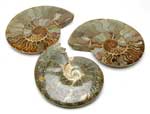 |
Pair of Large Ammonites From Madagascar. This matched pair of 6 1/2" diameter ammonites, Perisphinctes, are 150 million years old, from the island of Madagascar. Some of the best preserved and most beautiful ammonites in the world come from this island. The first of these two ammonites is whole, displaying a lovely creamy pattern of strengthening sutures contrasted against the dark brown color of the ammonite. The patterns of these sutures are like fingerprints, with no two species of ammonites having the same suture pattern. The second ammonite has been cut in two halves and polished to reveal the detail of the inner chambers. Ammonites added chambers as they grew and in this specimen, each chamber is excellently defined and filled with root-beer-colored calcite or green and brown, pastel-colored rock. These ammonites are both beautiful and interesting. Add $15 for domestic shipping.
Estimated Value $245 - 450.
View details and enlarged photo
| Realized
$184 |
Lot 825 |
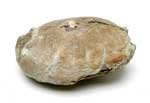 |
Pair of Therizinosaurus Eggs. Therizinosaurs were the most bizarre and unusual dinosaurs. They appear to have been a plant-eating theropod related to the raptors. Therizinosaurs walked bipodally with the body, long neck, and small head of a plant-eating dinosaur, but with up to two-feet claws on their hands. What they used the large claws for is unknown. This lot contains a 4" unhatched egg with over 85% of its original shell still in its red limestone matrix, as well as a 3 ½" unhatched, crushed egg that has calcified. The importance of such calcification is that embryonic bones have been found in 5-10% of calcified eggs. The only way to know for sure is to slowly etch the egg to expose any fragile bones. Both eggs are 65-70 million years old, from the Xixia Basin, Henan Province of China. Add $20 for domestic shipping.
Estimated Value $500 - 900.
View details and enlarged photo
| Realized
$431 |
Lot 826 |
 |
Partial Theropod Dinosaur Jaw With Four Teeth. Carcharondontosaurus saharicus was a large meat-eating dinosaur that was even larger than a T-Rex. This jaw section measures 6" x 2 1/2 " and contains four teeth that are 2-1 1/2" long. Even though the jaw segment is only fair, the four teeth have good enamel and serrations with only minor cracking of the enamel. One tooth does have an area of missing enamel close to the tip. The teeth have been put back into the jaw, but do have a rather uniform dark brown color and are well matched by size. This is still an impressive and rare partial jaw of a rare 70-80 million year old theropod dinosaur from the Sahara desert of Morocco. Add $20 for domestic shipping.
Estimated Value $700 - 1,000.
View details and enlarged photo
| Realized
$920 |
Lot 827 |
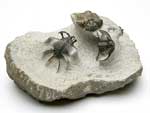 |
Professionally Prepared Grouping of Four Trilobites On A Single Block. These four trilobites have been carefully prepared in the same position that they were buried more than 375 million years ago in the Hamar Laghdad Formation in Morocco. Such careful and time-consuming preparation gives them the appearance of crawling over the rock. There are two of the spiny, eye-stalked trilobites - Ceratarges armatus - about 2" long with both their eye stalks and curved head spines cut free of the matrix. Next is a rare trilobite Thyganopeltis, 2" long with its shell patterned pygidium and small sharp spines. Lastly is a small 1" long Otarion turned on its side, almost like its flying with its small, stalked eyes cut free of the matrix. These four trilobites are crawling all over their 6" x 5" tan matrix. Add $35 for domestic shipping.
Estimated Value $1,000 - 1,500.
View details and enlarged photo
| Unsold |
Lot 828 |
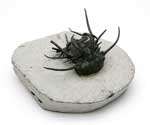 |
"Ram's" Horn Spiny Trilobite With Free-Standing Horns and Genal Spines. One of the most unusual and highly coveted of Moroccan trilobites is Dicranurus elegans, which is distinctive in having two long curved spines on its head resembling ram's horns. Found near Alnif, Morocco in the Sahara desert, Dicranurus is over 400 million years old. This 3" x 1 1/2" black trilobite has been painstakingly prepared and looks almost alive with the two horns and some of the long spines on its body and tail freestanding away from the matrix. Two of the body spines are only partials, but the overall appearance on its smooth 4" x 3" tan matrix is spectacular. Add $25 for domestic shipping.
Estimated Value $600 - 950.
View details and enlarged photo
| Unsold |
Lot 829 |
 |
Rare Hand Claw and Tooth From A New Dinosaur Discovery. Teeth from Deltadromeus agilis have been known for many years, but no skeleton was found until just a few years ago in Morocco. This 75-80 million-year-old predatory dinosaur was a Coelvirosaur, much smaller and slenderer than its distant relative, T-Rex. This lot contains a rare curved 1 1/2" hand claw, complete with a weathered tip and an excellent 1/2" tooth with the dangerous serrations still sharp and the brown enamel lustrous and hard. The very tip is a little worn from use when this dinosaur was alive. A fast predatory dinosaur, Dellodromeus was just a little larger than the Veloceratus in "Jurassic Park." Housed in a 5 1/2" x 4 1/2" Ryker mount for protection and display. Add $15 for domestic shipping.
Estimated Value $400 - 700.
View details and enlarged photo
| Unsold |
Lot 830 |
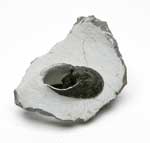 |
Space Ship Shaped Trilobite, Harpes. Trilobites come in every shape and size, which is what makes them so interesting to collect. There are more collectors of trilobites than any other type of fossil. Even though trilobites have been extinct for 250 million years, they were one of the first animals to have eyes and were successful and prolific for over 250 million years, first appearing in the fossil recored 520 million years ago. This unusual shaped trilobite, Harpes sp. is 375 million years old, from the Hamar Laghdad Formation of Morocco. It is just over 2" long and has been esthetically prepared so that it appears to be crawling through the light gray matrix. With its broad shield extending down and around the cephalon, ending in a sharp spine, it somewhat resembles an alien space craft. This specimen has been prepared to stand on its leveled base for dramatic display. Add $15 for domestic shipping.
Estimated Value $250 - 350.
View details and enlarged photo
| Realized
$230 |
Lot 831 |
 |
Ten Complete Trilobites On A Single Rock. It is rare to find two or more complete trilobites on a single block of stone, but finding ten complete trilobites from two different species is indeed special. These small black trilobites are over 375 million years old, from the Devonian Hamar Laghdad formation of Morocco. There are four of the interesting Chyphasis species trilobites, 1 1/2" - 1 3/4" long, with their two distinguishing horns jutting out from their cephalon. Also, interspersed on the matrix, are six Otarion species trilobites that have stalked eyes, bulbous nose, and a long tail spine. All ten trilobites are contained on their natural 8" x 6" light gray stone matrix. Add $20 for domestic shipping.
Estimated Value $350 - 500.
View details and enlarged photo
| Realized
$322 |
Lot 832 |
 |
Three and A Half Inch Long Morocconites Trilobite. This stunning 3 1/2" long 3-D trilobite Morocconites malladoides is over 375 million years old and was found near Issimour, Morocco. What makes this trilobite so special is the excellent detailed work done on it. First of all, the shell beneath the cephalon has been carefully revealed so that the thickness can be observed. The shell of a trilobite only covered the top side. The trilobite was exposed on its bottom side. Morocconites also had a strange curved spine that curved upward from its mouth. No one knows what the use was for this sharp curved spine. There is much small detail on this trilobite, including the compound, calcite-covered eyes which were somewhat like the eyes of a fly. Add $20 for domestic shipping.
Estimated Value $300 - 500.
View details and enlarged photo
| Realized
$288 |
Lot 833 |
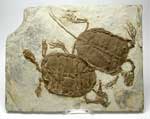 |
Two 130 Million Year Old Adult Turtles From China. From the very famous volcanic fossil beds of Liaoning, China, these exquisite complete adult turtles are displayed in the same position that they were overcome by the volcanic eruption of 130 million years ago. Turtle shells are not that rare in the fossil record, but complete turtles with heads, legs, and feet are. These primitive turtles, Manchurochelys liaoxiensis, are 11½" and 12½" long on a 16x12" gray stone matrix. They both possess excellent skulls, shells, legs and claws with just some minor disarticulation on two of the feet. The turtles are a lovely dark brown color contrasting nicely against the gray matrix. Although Manchurochelys looks like a modern turtle, they were primitive and could not withdraw their head and legs inside their shell. Finding one magnificently preserved early cretaceous turtle is rare, but a pair such as these would be the highlight of any fossil collection. Add $35 for domestic shipping.
Estimated Value $2,750 - 3,750.
View details and enlarged photo
| Realized
$7,130 |
Lot 834 |
 |
Two Fossil Fish On Same Matrix Block. 100 million year old guitarfish and herring-like fish on the same block. The most desired fish fossils come from Lebanon. They are so highly coveted because of their age: 100 million years, and the orange-brown color of preservation. This particular fossil limestone block contains both the rare Guitarfish, Rhinobatis, as well as a herring-like fish, Pseudoberyx. The rare 7 1/2" Guitarfish is nearly complete and is entirely cartilagenous, as is every relative of sharks and rays. The eyes, nose, tail, and some of the rays are defined. The smaller 6" herring-like fish is also nearly complete, with ribs and fins well defined, missing just the tip of the head. Different species of fish found in combination are very rare as fossils. All fossil rays are rare in the fossil record due to their delicate bone structure. Add $15 for domestic shipping.
Estimated Value $850 - 1,400.
View details and enlarged photo
| Realized
$1,150 |
Lot 835 |
 |
Two Large Chinese Water Dragons On One Matrix. This is an extremely rare 23" x 11" soft tuffaceous sandstone slab containing two large 21 1/2" and 20" Sinohydrosaurs. Sinohydrosaurus translates to Chinese water reptile and they are 130 million years old from Liaoning Province, China. Like the famous feathered dinosaurs, they too were buried in the massive volcanic eruption that occurred several times in the Liaoning area of Northeastern China. These two extraordinary specimens are virtually complete with one missing some toes and claws and the other is complete, with some minor disarticulation of some of the foot bones and claws. One specimen has some disarticulation on its skull which results in both the upper and lower jaws revealing their small sharp teeth. Teeth are rarely visible in the skulls. Both Sinohydrosaurs are light to dark brown on a cream-colored matrix. Being composed of soft volcanic ash, the stone is very soft and brittle and is near impossible to remove without breaking apart. The inevitable cracks in the matrix have been professionally smoothed over with gypsum to give it a nice even appearance. In addition, the matrix has been backed to give it more stability. Sinohydrosaurs are extremely popular in China because they consider them to be ancient dragons, which are considered to be good luck. Add $40 for domestic shipping.
Estimated Value $2,750 - 3,750.
View details and enlarged photo
| Realized
$4,600 |
|
|